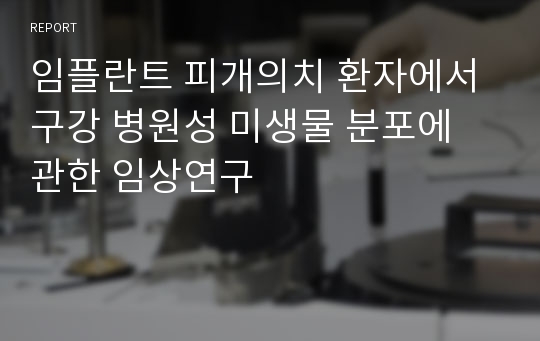임플란트 피개의치 환자에서 구강 병원성 미생물 분포에 관한 임상연구
황금댕댕이
다운로드
장바구니
* 본 문서는 한글 2005 이상 버전에서 작성된 문서입니다. 한글 2002 이하 프로그램에서는 열어볼 수 없으니, 한글 뷰어프로그램(한글 2005 이상)을 설치하신 후 확인해주시기 바랍니다.
목차
국문 초록감사의 글
목차
표 차례
그림 차례
Ⅰ. 서론
Ⅱ. 연구재료 및 방법
Ⅲ. 연구결과
논문사진 부도
Ⅳ. 토의
Ⅴ. 결론
참고문헌
외국어 초록
본문내용
Ⅰ. 서론최근 의학과 기술의 발달로 인한 노인 인구의 증가는 무치악 환자의 증가로 이어지나 모든 무치악 환자가 다수의 임플란트를 심을 수 있는 상황은 아니므로 비교적 예지성 있고 성공적인 결과를 보이는 것으로 알려진 임플란트 피개의치 치료법이 주목을 받고 있다(1).
다수의 치아 상실로 무치악 환자의 경우 잔존치조제의 흡수, 구강 안면지지의 상실, 저작 기능의 저하 등이 초래된다(2, 3). 치아를 다수 상실하는 것과 의치를 사용해야 한다는 것, 무엇보다도 의치의 불안정성은 환자에게 실망감을 줄 수 있다(2, 3). 이러한 무치악 환자의 치료에 있어서 총의치를 이용한 수복은 심미성과 기능을 어느 정도 회복시킬 수 있지만, 안정성과 유지력은 특히 오래된 무치악 하악의 경우에 좋지 않다. 임플란트를 이용하여 의치의 유지 및 지지를 향상시키면 저작, 심미의 개선뿐 아니라 일상생활에서 정신적 안정감을 줄 수 있으며, 임플란트 식립은 잔존치조제의 흡수를 늦출 수 있다는 장점을 갖는다고 보고되었다 (1, 4, 5). 또한 환자의 만족도, 저작력의 개선, 의치의 안정성 면에서 임플란트 피개의치가 전통적인 의치를 대체하는 매우 성공적인 치료법이라는 것에 대해서는 많은 연구결과가 보고되었다 (6-8).
그 동안 치과 임플란트 술식의 보편화와 더불어 구강 내 임플란트 주위 감염과 연관된 세균총에 대한 연구는 비교적 활발히 진행되어 왔다 (22, 24, 26). 기존의 연구에 따르면 건강한 상태의 치주조직에서는 치주질환에 이환된 조직과 비교하여 적은 수의 세균이 치은 열구 내에 존재하며, 분포 세균 군에 있어서 다른 양상을 보인다 (44, 45). 정상조직에서는 주로 그람 양성 통성균인 Streptococcus (Streptococcus sanguinis, Streptococcus mitis)가 존재하며 (9, 10), 적은 양의 그람 음성균인 Prevotella intermedia, Fusobacterium nucleatum, Capnocytophaga등이 존재하는 것으로 보고되었다 (11).
참고 자료
Feine JS, Carlsson GE, Awad MA, Chehade A, Duncan WJ, Gizani S, Head T, Heydecke G, Lund JP, MacEntee M, Mericske-Stern R, Mojon P, Morais JA, Naert I, Payne AG, Penrod J, Stoker GT, Tawse-Smith A, Taylor TD, Thomason JM, Thomson WM, and Wismeijer D. (2002) The McGill consensus statement on overdentures. Mandibular two-implant overdentures as first choice standard of care for edentulous patients. Gerodontology, 19(1):3-4.van Waas MA. (1990) The influence of clinical variables on patients' satisfaction with complete dentures. J Prosthet Dent, 63(3):307-10
Gunne, H. S., Bergman, B., Enbom, L., and Hogstrom, J. (1982) Masticatory efficiency of complete denture patients: a clinical examination of potential changes at the transition from old to new denture. Acta Odontol Scand, 40:289–297.
von Wowern N, Harder F, Hjørting-Hansen E, and Gotfredsen K. (1991) An ITI-implant supported overlay dentures--prevention of bone resorption in the edentulous mandible. Quintessenz, 42(3):383-91.
von Wowern N, Gotfredsen K. (2001) Implant-supported overdentures, a prevention of bone loss in edentulous mandibles? A 5-year follow-up study. Clin Oral Implants Res, 12(1):19-25.
Burns DR, Unger JW, Elswick RK Jr, and Beck DA. (1995) Prospective clinical evaluation of mandibular implant overdentures: Part I--Retention, stability, and tissue response. J Prosthet Dent, 73(4):354-63.
Burns DR, Unger JW, Elswick RK Jr, and Giglio JA. (1995) Prospective clinical evaluation of mandibular implant overdentures: Part II--Patient satisfaction and preference. J Prosthet Den, 73(4):364-9.
Ju-Hee Hong, Gyu-Un Jung, Sang-Wan Shin, Eun-Kyoung Pang. (2015) A prospective study of patient satisfaction after implant supported mandibular overdenture treatment in fully edentulous patients. J Korean Acad Prosthodont, 53:1-8.
Furst MM, Salvi GE, and Lang NP (2007) Persson GR. Bacterial colonization immediately after installation on oral titanium implants. Clin Oral Implants Res, 18:501-8.
De Boever AL, De Boever JA. (2006) Early colonization of non-submerged dental implants in patients with a history of advanced aggressive periodontitis. Clin Oral Implants Res, 17:8-17.
Mombelli A, Mericske-Stern R. (1990) Microbiological features of stable osseointegrated implants used as abutments for overdentures. Clin Oral Implants Res, 1;1-7.
Xu P, Alves JM, Kitten T, Brown A, Chen Z, Ozaki LS, Manque P, Ge X, Serrano MG, Puiu D, Hendricks S, Wang Y, Chaplin MD, Akan D, Paik S, Peterson DL, Macrina FL, and Buck GA. (2007) Genome of the Opportunistic Pathogen Streptococcus sanguinis J Bacteriol, 189(8):3166-75.
Ahmed, R., T. Hassall, B. Morland, and J. Gray. (2003) Viridans streptococcus bacteremia in children on chemotherapy for cancer: an underestimated problem. Pediatr Hematol Oncol, 20:439–444
Mysak J, Podzimek S, Sommerova P, Lyuya-Mi Y, Bartova J, Janatova T, Prochazkova J, and Duskova J. (2014) Porphyromonas gingivalis: major periodontopathic pathogen overview. J Immunol Res, 27:288-294.
Dashper SG, Seers CA, Tan KH, and Reynolds EC. (2011) Virulence Factors of the Oral Spirochete Treponema denticola. J Dent Res, 90(6):691.
Karim AY, Kulczycka M. Kantyka T, Dubin, G, Jabaiah A, Daugherty PS, Thogersen IB, Enghild JJ, Nguyen KA, and Potempa, J. (2010) A novel matrix metalloprotease-like enzyme (karilysin) of the periodontal pathogen Tannerella forsythia ATCC 43037. Biological Chemistry, 391:105–117.
Siddiqi A, Milne T, Cullinan MP, and Seymour GJ. (2016) Analysis of P. gingivalis, T. forsythia and S. aureus levels in edentulous mouths prior to and 6 months after placement of one-piece zirconia and titanium implants. Clin Oral Implants Res, 27(3):288-94.
Dorn BR, Leung KL, and Progulske-Fox A. (1998) Invasion of Human Oral Epithelial Cells by Prevotella intermedia. Infection and Immunity, 66(12):6054-719. Bolstad AI, Jensen HB, and Bakken V. (1996) Taxonomy, biology, and periodontal aspects of Fusobacterium nucleatum. Clin Microbiol Rev, 9(1):55-71.
Aruni AW, Roy F, and Fletcher HM. (2011) Filifactor alocis has virulence attributes that can enhance its persistence under oxidative stress conditions and mediate invasion of epithelial cells by porphyromonas gingivalis. Infect Immun, 79(10):3872-86.
Lombardo Bedran TB, Marcantonio RA, Spin Neto R, Alves Mayer MP, Grenier D, Spolidorio LC, and Spolidorio DP. (2012) Porphyromonas endodontalis in chronic periodontitis: a clinical and microbiological cross-sectional study. J Oral Microbiol, doi: 10.3402/jom.v4i0.10123.
Mombelli A, Marxer M, Gaberthüel T, Grunder U, and Lang NP. (1995) The microbiota of osseointegrated implants in patients with a history of periodontal disease. J Clin Periodontol, 22(2):124-30.
Danser MM, van Winkelhoff AJ, and van der Velden U. (1997) Periodontal bacteria colonizing oral mucous membranes in edentulous patients wearing dental implants. J Periodontol, 68: 209-16.
Apse P, Ellen R. , Overall C and Zarb G. (1989) Microbiota and crevicular fluid collagenase activity in the osseointegrated dental implant sulcus: A comparison of sites in edentulous and partially edentulous patients. J Periodont Res, 24(2):96–105.
Botero JE, Gonzalez Am, Mercado RA, and Olave G, Contreras A. (2005) Subgingival microbiota in peri-implant mucosa lesions and adjacent teeth in partially edentulous patients. J Periodontol, 76:1490-5. 32.
Mombelli A, Van Oosten MAC, Schürch E, and Lang NP. (1987) The microbiota associated with successful or failing osseointegrated titanium implants. Oral Microbiol Immunol, 2:145-51. 33.
Shibli JA, Melo L, Ferrari DS, Figueiredo LC, Faveri M, and Feres M. ( 2008) Composition of supra- and subgingival biofilm of subjects with healthy and diseased implants. Clin Oral Implants Res, 19:975-82. 34.
Tabanella G, Nowzari H, and Slots J. (2009) Clinical and microbiological determinants of ailing dental implants. Clin Implant Dent Relat Res, 11:24-36.
Tezal M, Scannapieco FA, Wactawski-Wende J, Grossi SG, and Genco RJ. (2006) Supragingival plaque may modify the effects of subgingival bacteria on attachment loss. J Periodontol, 77(5):808-13.
Danser MM, van Winkelhoff AJ, de Graaff J, Loos BG, and van der Velden U. (1994) Short-term effect of full-mouth extraction on periodontal pathogens colonizing the oral mucous membranes. J Clin Periodontol, 21:484-9. 28.
Danser MM, van Winkelhoff AJ, de Graaff J, and van der Velden U. (1995) Putative periodontal pathogens colonizing oral mucous membranes in denture-wearing subjects with a past history of periodontitis. J Clin Periodontol, 22:854-9.
Socransky SS, Haffajee AD. (2005) Periodontal microbial ecology. Periodontol 2000, 38:135-87.
Quirynen M, Vogels R, Peeters W, van Steenberghe D, Naert I, and Haffajee A. (2012) Dynamics of initial subgingival colonization of ‘pristine’ peri-implant pockets. Clin Oral Implants Res, 17:25-37.
Yasui M, Ryu M, Sakurai K, and Ishihara K. (2012) Colonisation of the oral cavity by periodontopathic bacteria in complete denture wearers. Gerodontology, 29(2):e494-502.
Socransky SS, Haffajee AD, Cugini MA, Smith C, Kent RL Jr. (1998) Microbial complexes in subgingival plaque. J Clin Periodontol, 25:134-44.
Horz HP, Robertz N, Vianna ME, Henne K, and Conrads G. (2015) Relationship between methanogenic archaea and subgingival microbial complexes in human periodontitis. Anaerobe, 35(Pt A):10-2.
Quirynen M, Van Assche N. (2011) Microbial changes after full-mouth extraction, followed by 2-stage implant placement. J Clin Periodontol, 38:581-9.
Boutaga K, Savelkoul PH, Winkel EG, and van Winkelhoff AJ. (2007) Comparison of subgingival bacterial sampling with oral lavage for detection and quantification of periodontal pathogens by real-time polymerase chain reaction. J Periodontol, 78(1):79-86.
Cortelli SC, Cortelli JR, Romeiro RL, Costa FO, Aquino DR, and Orzechowski PR. (2013) Frequency of periodontal pathogens in equivalent peri-implant and periodontal clinical statuses. Arch Oral Biol, 58(1):67-74.
Muthukuru M, Zainvi A, Esplugues EO, Flemmig TF. (2012) Non-surgical therapy for the management of peri-implantitis: asystematic review. Clin Oral Implants Res, 23(6):77-83.
Chawla TN, Nanda RS, Kapoor KK. (1975) Dental prophylaxis procedures in control of periodontal disease in Lucknow (rural) India. J Periodontol, 46(8):498-503.
Majed M Masadeh, Shadi F Gharaibeh, Karem H Alzoubi, Sayer I Al-Azzam, and Wasfi M Obeidata. (2013) Antimicrobial Activity of Common Mouthwash Solutions on Multidrug-Resistance Bacterial Biofilms. J Clin Med Res, 5(5):389–394.
Brook I. (2003) Mouthrinses and periodontal disease. Gen Dent, 51(5):424-8.
Moore WE, Moore LV. (1994) The bacteria of periodontal diseases. periodontol 2000, 5:66.
Slots J, Genco RJ. (1984) Black-pigmented bacteriodes species, Capnocytophaga species and Actinobacillus actinomycetemcomitans in human periodontal disease; virulence factores in colonization, survival and tissue destruction. J Dent Res, 63:412.
Sheets SM, Robles-Price AG, McKenzie RM, Casiano CA and Fletcher HM. (2008) Gingipain-dependent interactions with the host are important for survival of Porphyromonas gingivalis. Front Biosci, 1(13):3215-38.
Okamoto M, Maeda N, Kondo K, Leung KP. (1999) Hemolytic and hemagglutinating activities of Prevotella intermedia and Prevotella nigrescens. FEMS Microbiol Lett, 15:299-304.
Kim YJ, Lee SH. (2014) Reducing the bioactivity of Tannerella forsythia lipopolysaccharide by Porphyromonas gingivalis. J Microbiol, 52(8):702-8.
Al-Radha AS, Pal A, Pettemerides AP and Jenkinson HF. (2012) Molecular analysis of microbiota associated with peri-implant diseases. J Dent, 40(11):989-98.
Zhuang LF, Watt RM, Mattheos N, Si MS, Lai HC and Lang NP. (2016) Periodontal and peri-implant microbiota in patients with healthy and inflamed periodontal and peri-implant tissues. Clin Oral Implants Res, 27(1):13-21.
Fraga D, Meulia T, Fenster S, Gallagher S.R. and Wiley E.A. (2008) Current Protocols Essential Laboratory Techniques. Second edition. John Wiley & Sons, Inc., West Sussex, UK. p. 10.3.18-20.
Sordyl CM, Simons AM and Molinari JA. (1995) The microbial flora associated with stable endosseous implants. J Oral Implantol. 21(1):19-22.




























